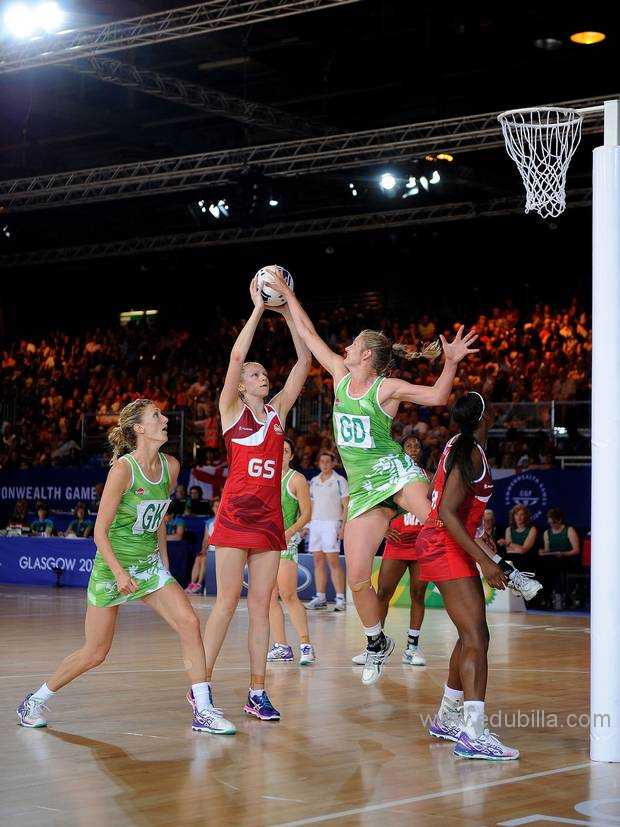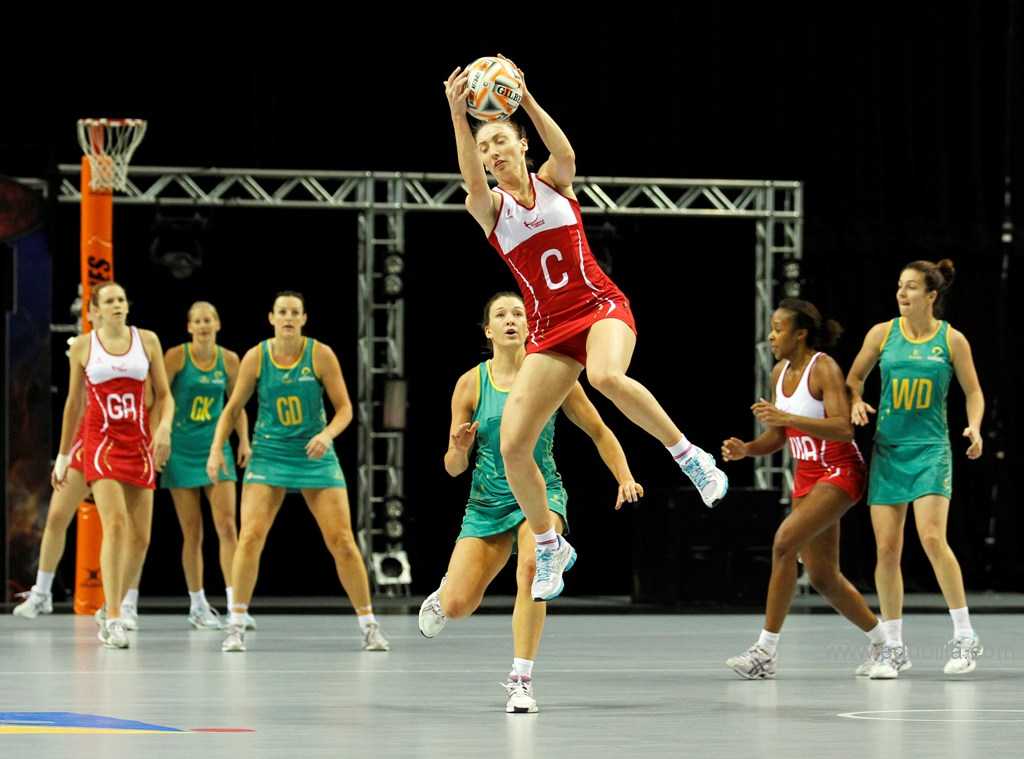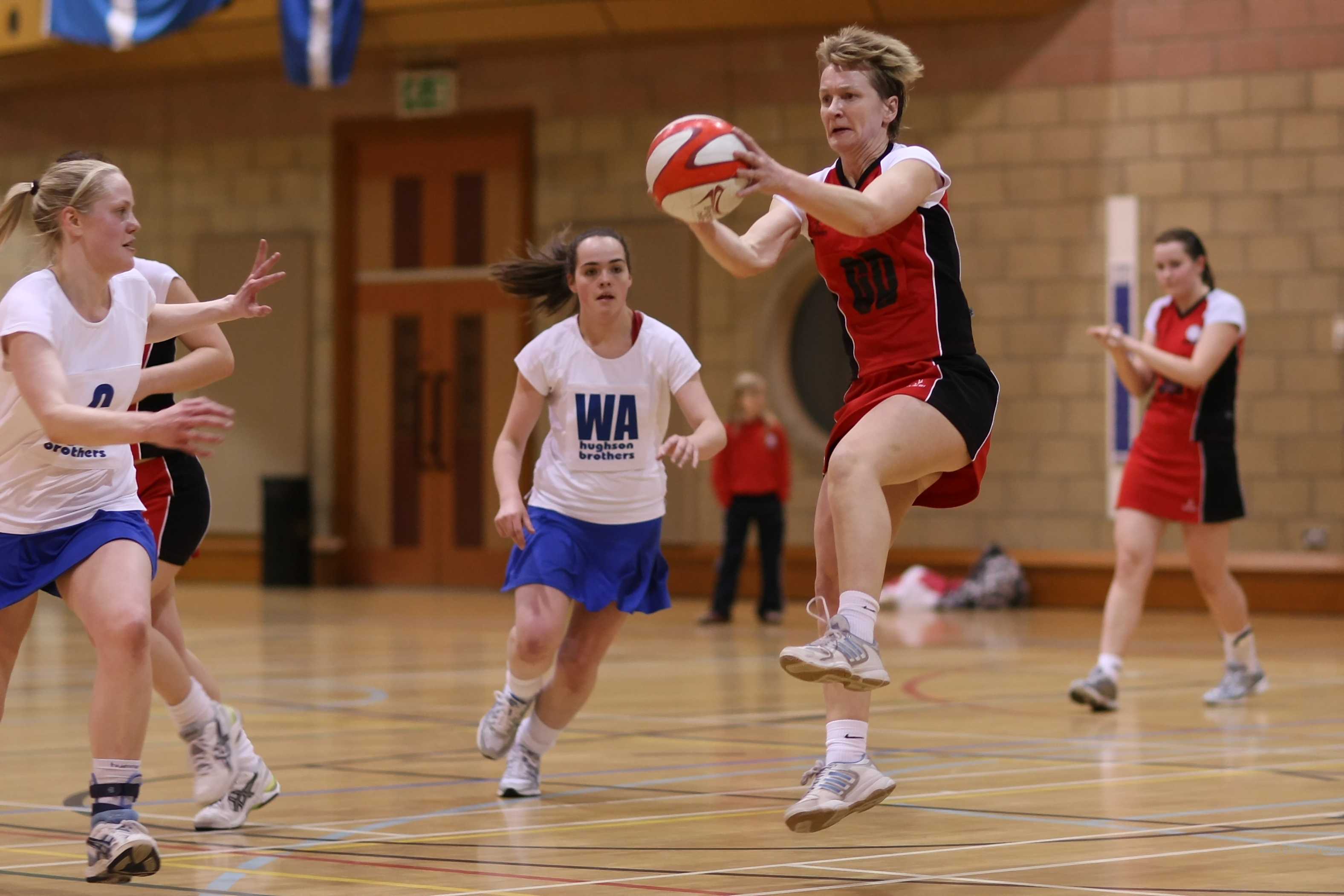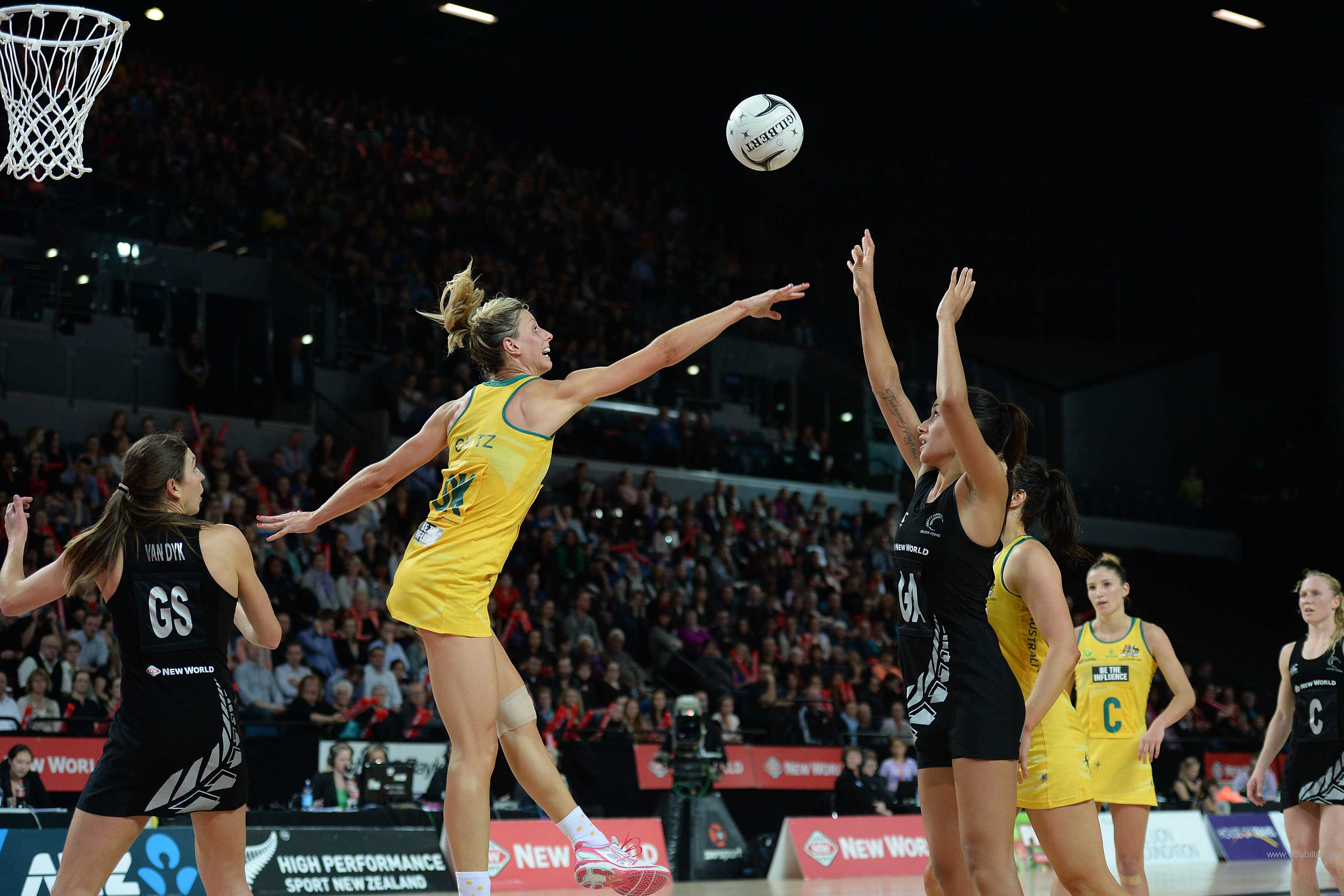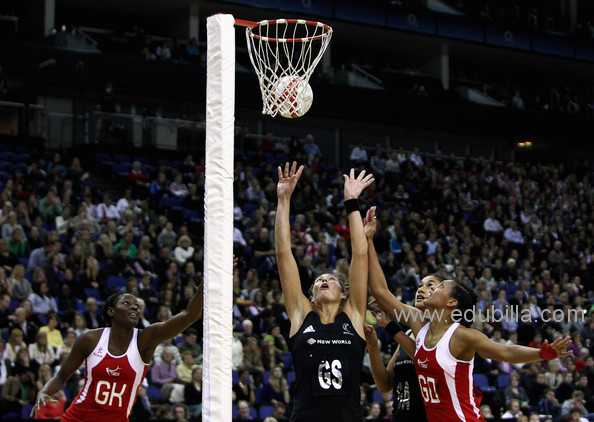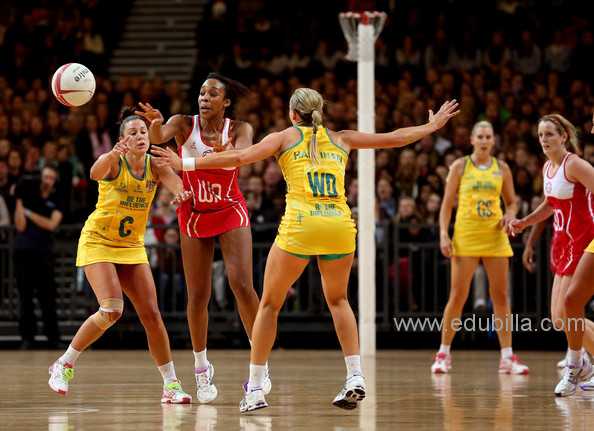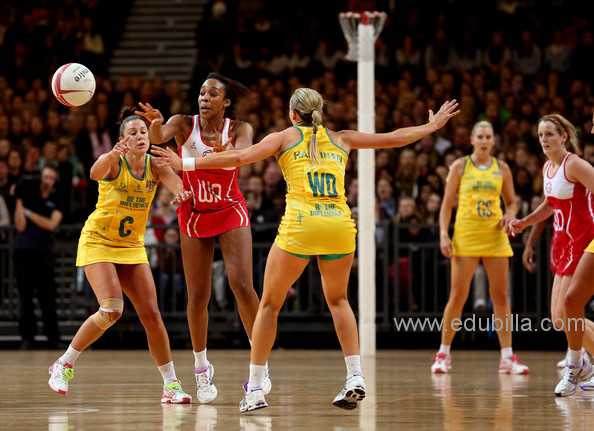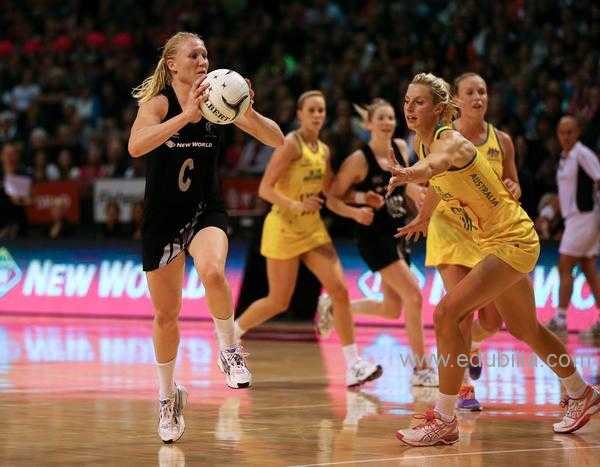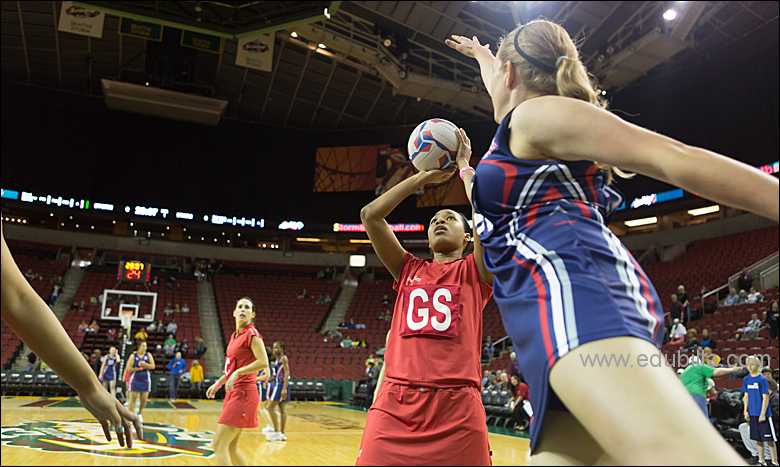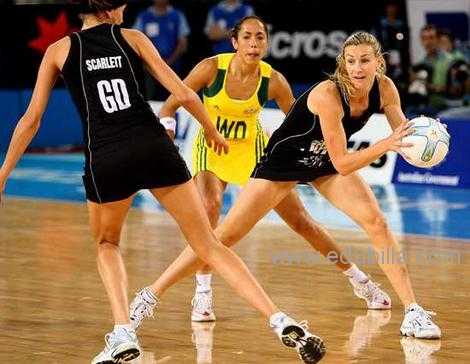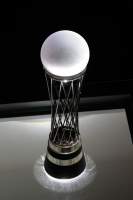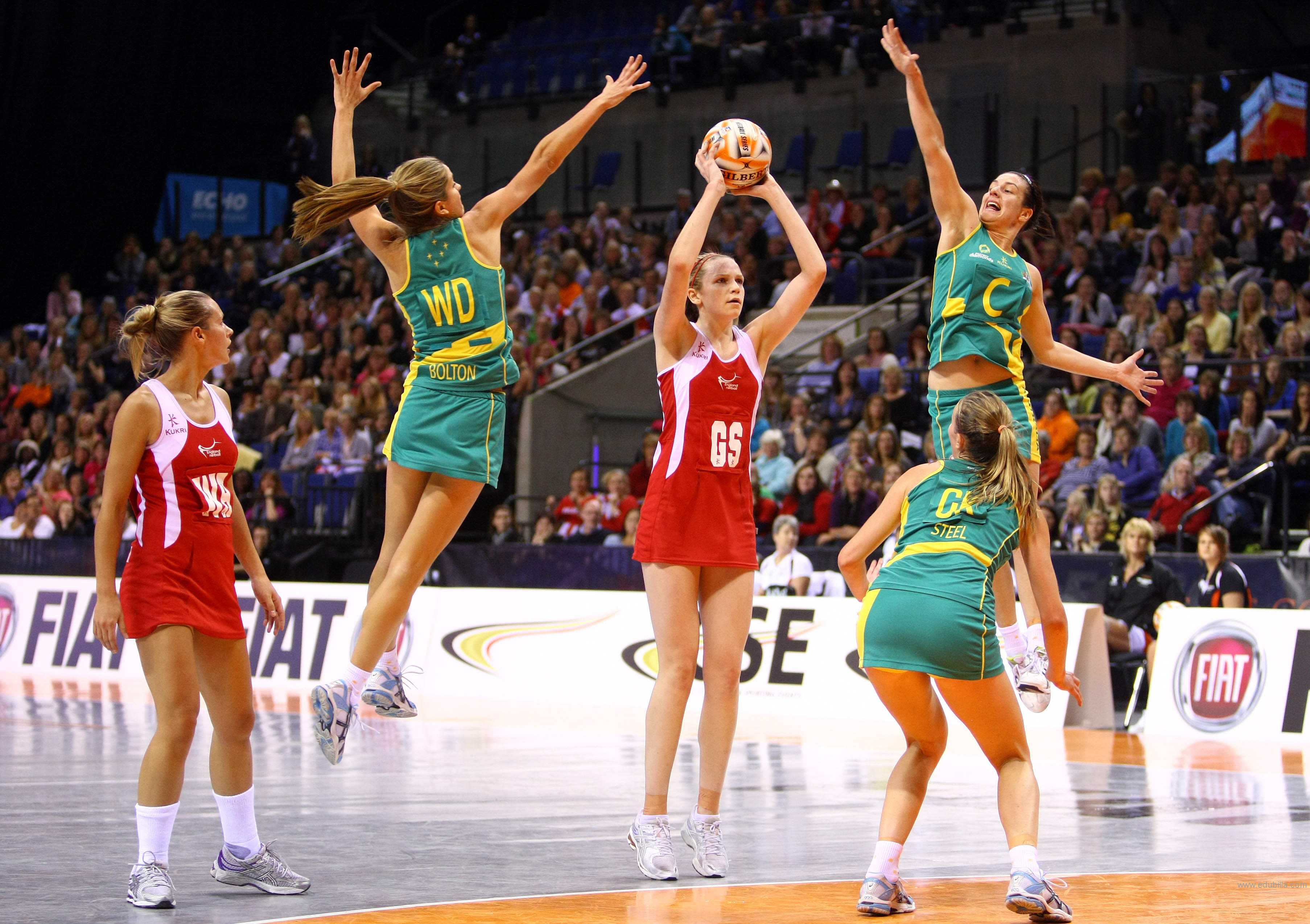
Overview Of Netball
Netball is a ball sport played by two teams of seven players. Its development, derived from early versions of basketball, began in England in the 1890s. By 1960, international playing rules had been standardised for the game, and the International Federation of Netball and Women's Basketball (later renamed the International Netball Federation (INF)) was formed. As of 2011, the INF comprises more than 60 national teams organized into five global regions.
Games are played on a rectangular court with raised goal rings at each end. Each team attempts to score goals by passing a ball down the court and shooting it through its goal ring. Players are assigned specific positions, which define their roles within the team and restrict their movement to certain areas of the court. During general play, a player with the ball can hold onto it for only three seconds before shooting for a goal or passing to another player. The winning team is the one that scores the most goals. Netball games are 60 minutes long. Variations have been developed to increase the game's pace and appeal to a wider audience.
Netball is most popular in Commonwealth nations, specifically in schools, and is predominantly played by women. According to the INF, netball is played by more than 20 million people in more than 80 countries.Major transnational competitions take place, including the Netball Superleague in Great Britain and the ANZ Championship in Australia and New Zealand. Three major competitions take place internationally: the quadrennial World Netball Championships, the Commonwealth Games, and the yearly World Netball Series. In 1995, netball became an International Olympic Committee recognised sport, but it has not been played at the Olympics.
Game Rules
Netball is a ball sport for two teams of seven players, predominantly played by women; its rules are published in print and online by the International Netball Federation. Games are played on a rectangular court divided into thirds, with a raised goal at each short end. The object of the game is for teams to score goals, by passing a ball and shooting it into their team's goal ring. Players are assigned "positions" that define their role within the team and restrict their movement on court.
During general play, a player with the ball can take no more than one step before passing it, and must pass the ball or shoot for goal within three seconds. Goals can only be scored by the assigned shooting players. Netball games are 60 minutes long, divided into 15-minute quarters, at the end of which the team with the most goals scored wins.
History of the rules:
In 1893, Martina Bergman-Österberg informally introduced one version of basketball to her female physical training students at the Hampstead Physical Training College in London, after having seen the game being played in the United States.The rules of this game were modified at Madame Österberg's college over several years. Substantial revisions were made during a visit in 1897 from another American teacher, Miss Porter, who introduced rules from women's basketball in the United States; the game also moved outdoors onto grass courts, the playing court was divided into three zones, and the baskets were replaced with rings that had nets.By 1960, the rules of netball were standardised internationally. An international governing body was formed to oversee the sport globally, now called the International Netball Federation (INF).
At the INF Congress 2013 in Glasgow, the INF announced that the Rules of Netball would be freely available online for individual use to assist the growth and development of the sport.
Objective:
The objective of a game of netball is to score more goals than the opposition. Goals are scored when the ball is passed to team members in the goal circle who then shoot the ball through the goal ring
Court and dimensions:
Netball is played on either a hard or soft court with scoring hoops or "rings" at both ends. The court is slightly larger than a basketball court, being 30.5 metres (100 ft) long and 15.25 metres (50.0 ft) wide.The longer sides are called "side lines" and the shorter sides are called "goal lines" or "back lines".The two lines dividing the court into thirds are called "transverse lines".Court markings are no more than 50 millimetres (2.0 in) wide.The court is divided into thirds which regulate where individuals of each position are allowed to move.A 0.9-metre (3 ft)-diameter "centre circle" is located in the centre of the court.At each end of the court there is a 4.9-metre (16 ft)-radius semi-circular "shooting circle" or "goal circle" from within which all scoring shots must be taken.The goal posts are 3.05 metres (10.0 ft) high from the top of the ring to the ground and have no backboards.The rings have an internal diameter of 380 millimetres (15 in), and are located 150 millimetres (5.9 in) forward from the post and are made of 15-millimetre (0.59 in) diameter steel.
Ball:
The ball is made of leather, rubber or similar material, measures 680 millimetres (27 in) to 710 millimetres (28 in) in circumference and weighs 397 grams (14.0 oz) to 454 grams (16.0 oz).For INF sanctioned competitions, Gilbert is the official supplier of netball balls
Playing time:
A game is played in four quarters, each lasting fifteen minutes.There are intervals of three minutes between the first and second quarters and between the third and fourth quarters, and an interval of five minutes at half time.If an umpire or player calls time, the time keeper pauses the timer. When play resumes, the timer is restarted. A maximum of two minutes is allowed for an injury.
Positions:
There are seven players on each team,who are given nominated, named positions. Each player must wear a "bib" showing one of the abbreviations below, indicating that player's position.Each player is only allowed in certain areas of the court: a player in a section of the court that is not part of their playing area is deemed "offside".
Detailed Football Rules Can Be Downloaded From Documents
Equipments Need For Netball
Ball
- two different netball official sizes
- for young netball players ranging from ages 8 - 10 years (whick is sometimes called netta): size 4 ball
- for ages 10 years old and up is a official size (Netball) : size 5 ball
Goal Posts:
Two post, one positioned at each end of the court.
- recommended for ages 8 - 10 years (called netta): post height 2.4 meters or 8 feet high
- for ages 10 years old and up regular netball post height is 3.05 meters or 10 feet high just like basketball
Bibs:
Positional bibs or patches marked with the seven positions must be worn.
Court:
See diagram 1 below.
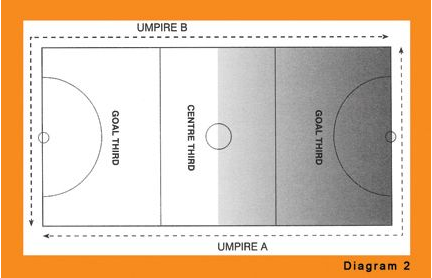
Goal Posts
Two posts, one positioned at each end of the court:
• Ages 8 – 10 years (Modified): 2.4 metres (8 feet) high.
• Ages 10+ years (Netball): 3.05 metres (10 feet) high.Umpires
Two umpires control a game, each looking after the half of the court to their right. See diagram 2 below.
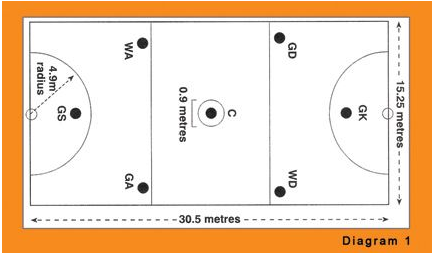
Players:
A netball team consists of seven players, one in each of the following positions:
GK – Goal Keeper
GD – Goal Defence
WD – Wing Defence
C – Centre
WA – Wing Attack
GA – Goal Attack
GS – Goal ShooterBibs
Positional bibs or patches marked with the seven positions must be worn.
Detailed Netball Rules Can Be Downloaded From Documents
History Of Netball
The history of netball goes back to 1891 in Springfield, Massachusetts when a 30-year-old Canadian immigrant to the USA, James Naismith, was ordered to invent an indoor game for high-spirited young men at the School for Christian Workers (later the YMCA).
The History of Netball at a Glance:
1895-In England in 1895, ladies using broomsticks for posts and wet paper bags for baskets played the basketball game on grass. Their long skirts, bustle backs, nipped waists and button up shoes impeded running and their leg-of-mutton sleeves restricted arm movement making dribbling and long passes difficult. The ladies decided to adapt the game to accommodate these restrictions.
1898-In 1898 the court was divided into thirds, the number of players increased from five to nine and a smaller ball (a soccer ball) was used. There were two umpires, two scorers and two timekeepers – almost as many officials as players for each match.
In those early days the nets were not open at both ends and after each goal was scored, the umpire had the task of retrieving the ball from the top of the post.
1901-In England in 1901 the first set of rules was published and ‘netball’ officially came into existence in that country. At the turn of the century school teachers from England travelled to many countries of the then British Empire, and the game of netball or “ladies basketball” (if prior to 1901) went with them.
Once established, the game developed locally and soon each country had its own separate rules and distinct methods of play, even its own name for the game. In Australia and New Zealand where the game was established before 1901, it was called Women’s Basketball and the name was changed to Netball in these two countries in 1970.
1927-1928-The All Australia Women’s Basketball Association was formed in August 1927, and the first official National Championships was held in Melbourne in 1928, although a number of interstate matches had taken place earlier.
1938-Australia’s first International match was played in 1938 against New Zealand during the National Championships in Melbourne, with Australia defeating New Zealand 40-11.
1939-In 1939, an Australian team was selected to tour New Zealand, but with the outbreak of war the tour was abandoned and it was not until 1948 that a tour took place. Australia by this time was playing a seven-a-side game but New Zealand (until 1956) played nine-a-side, although the seven-a-side game was played on this tour.
1957-A landmark in the history of Netball was when Australia travelled by ship to be the first overseas team to visit England. It was a Women’s Basketball team going to the birthplace of netball, and having to adapt to different rules, but the Australian team won 54 of 57 games, including the Test against England (14-11) at Wembley Stadium before a crowd of more than 5,000.
Following this successful tour, a conference was held in London in 1957 to agree on an International Code of Rules to be trialled in each country over the next three years. Countries represented at this conference were England, New Zealand, Northern Ireland, South Africa, USA, Wales and Australia.
1960-In 1960, the International Federation of Women’s Basketball and Netball Associations became a reality at a conference in Ceylon (Sri Lanka) attended by representatives from England, Ceylon, South Africa, West Indies, New Zealand and Australia.
1963-In 1963, the first World Tournament with 11 teams competing, was held in England and Australia were undefeated. World Championships are staged every four years and Australia has been titleholders on eight occasions.
1990-Netball was a demonstration sport at the Auckland Games in 1990 but was not included in the Commonwealth Games program for the first time until 1998 in Kuala Lumpur. Australia won the Commonwealth Games Gold Medal in 1998 and 2002, although they were unable to defend their title in Melbourne in 2006, losing the gold medal to New Zealand 60:55 in a closely fought final.
2007-Australia has claimed the World Championship title in nine of the 12 World Netball Championships held since 1963, including the 2007 World Netball Championships where they defeated New Zealand 42-38 in Auckland.
1963 world tournament:
Standardised rules opened the door for the first basketball world tournament, played in England in 1963. The New Zealand players faced an arduous five-week ship passage as their build-up, training on deck every day and losing balls overboard.
The New Zealand team, which included future netball matriarch Lois Muir, finished runners-up at the tournament. They lost their final game to Australia by one goal – setting the scene for future intense trans-Tasman encounters.
Nine-a-side:
Jamieson introduced a nine-a-side game, which was played on grass courts. This version of the game was different from men’s basketball. The art of dribbling the ball had disappeared. Heavy floor-length skirts and leg-o’-mutton sleeves restricted women players’ movement, so instead the ball was passed from hand to hand. Lines were drawn on the court to mark where players could and could not go.
A new name:
It was not until 1970 that the sport became officially known as netball in New Zealand. Referees became known as umpires.
By then, the game had moved from grass to asphalt outdoor courts. It was played by school teams and competitive club sides, and social mid-week fixtures also allowed housewives and mothers to participate, bringing their children to the courts. In 1976 there were more than 6,000 senior teams and 2,800 primary-school teams in New Zealand.
The game itself was constantly becoming more physical. Although it was deemed a non-contact sport, players began moving the ball through court more quickly and contesting the ball with greater ferocity. The rules have been constantly fine-tuned to adjust to the more athletic style of netball.
Universal rules:
If New Zealand was to become part of the burgeoning netball world, a universal set of rules had to be agreed. The first international rules were drawn up in 1957 and applied throughout New Zealand two years later. The most crucial change was making the game seven-a-side.
At this stage basketball was still a ladylike affair where it was frowned upon to defend a shot at goal or contest a rebound. Married women were discouraged from playing the sport, with teams often disqualified if they were found to have ‘post-maritals’ in their line-up.
Men’s netball:
While netball is a predominantly female game, the New Zealand Men’s and Mixed Netball Association continues to grow in strength. It had its origins in the New Zealand Men’s Netball Association, formed in 1984 soon after men began playing the sport in New Zealand. The association amalgamated with Netball New Zealand in 1996.
In 2012 there were 15 teams competing in a national tournament. Since 1985 New Zealand and Australia have played a trans-Tasman series every second year.
Men’s netball is played in 14 countries, but receives less attention from sponsors and spectators than the women’s version of the sport. Men’s netball has yet to gain membership of the International Federation of Netball Associations (IFNA).
There are a number of male umpires of the women’s game at the highest level.
The world Over netball:
Over 20 million people play netball throughout the world, in more than 80 countries. The sport’s strength comes from Commonwealth nations, but it is also growing in Zimbabwe, Taiwan and the United States.
The top four nations are traditionally New Zealand, Australia, England and Jamaica. Trans-Tasman rivalry between the Australian Diamonds and the Silver Ferns – the teams are often separated by only one goal after 60 minutes – has also heightened interest in international clashes.
Origin Of Netball
The game originated in the United States. Teacher James Naismith invented men’s basketball in 1891 at the School for Christian Workers (later the YMCA) in Springfield, Massachusetts. Female teachers who watched the new game of a ball being thrown into a high peach basket became captivated by it and started playing their own version.
Arrival in New Zealand:
It is commonly thought that ‘women’s basketball’ was introduced to New Zealand in 1906 by the Reverend J. C. Jamieson, travelling secretary of the Presbyterian Bible Class Union. He had seen the game being played in Australia and thought it was ideal for teenage girls. In 1907 a demonstration game was played by YMCA and Bible class teams in a paddock in Mt Eden, Auckland.
The First Basketball court:
The game was first played in the campus gymnasium on a court roughly half the size of a regulation NBA court today, between two teams of nine players. It was played with a soccer ball that was shot into closed-bottom peach baskets that were nailed to the gymnasium wall.
The First Game of Netball:
The first game of netball played at Madame Ostenburg’s College, England in 1895, through to inclusion in the Commonwealth Games in 1998 and the instigation of Fast Net in 2008 and Fast5 in 2013
The First Netball Rules:
The first codified rules of netball were published in 1900 or 1901by the Ling Association (later the Physical Education Association), with 250 copies of the rules published. From England, the game of netball was spread to all corners of the British Empire.
The first international game of netball:
Australia and New Zealand contested the first international game of netball (still called "women's basketball" in both countries) in 1938, when the New Zealand team toured Australia, playing local and state teams as well as the Australian national team. At the time, Australia played seven-a-side netball, while New Zealand played nine-a-side. For these matches, Australian seven-a-side netball was adopted, along with some netball rules from England.
Governing Bodies
The International Netball Federation (INF), formerly the "International Federation of Netball Associations" (IFNA), is the worldwide governing body for netball. The INF was created in 1960 and is responsible for world rankings, maintaining the rules for netball and organising the World Netball Championships. The organisation has five regional areas: Africa, the Americas, Asia, Europe and Oceania.
General information:
The organisation is based in Manchester, England.The INF has over 70 national members which are grouped into five regional areas: Africa, Asia, Americas, Europe and Oceania.The INF is governed by a congress that meets every two years, a board of directors that meets three times a year, a chief executive officer and a Secretariat.It is also responsible for providing world rankings for national representative teams.The INF organises several major international competitions including the Netball World Championships.It is also a signatory to the World Anti-Doping Code.
History of INF:
In 1957, a pair of national netball organisations discussed the need to create an international governing body for the sport to help address issues like standardising the rules.International Federation of Netball Associations|2008}.This conversation was started between England and Australia, while Australia was touring England.In 1960, netball representatives from Australia, England, New Zealand, South Africa and the West Indies finally gathered to create the needed organisation, the International Federation of Women's Basketball and Netball.The meeting took place in Sri Lanka, with rules for the newly creating organisation being created.A decision was made at this first meeting create a world championship competition for the sport to be held every four years, with the first event to be held in 1963 in Eastbourne, England.
The organisation has since undergone several changes. After all countries adopted the name "netball" for the sport, the organisation was renamed the "International Federation of Netball Associations" (IFNA). This name was used until November 2012, when the organisation changed to its current name, the "International Netball Federation", to bring it in line with other sports governing bodies.
Awards Related To Netball
AUSTRALIAN NETBALL AWARDS:
The Australian Netball Awards is netball’s ‘night of nights’, held every year at the conclusion of domestic and international calendars – a time when the netball community comes together to celebrate the achievements of players, coaches, officials and media.
Goalden Globe Awards:
The great and good of the sport flocked to Sheffield City Hall on Saturday evening as the annual Goalden Globe Awards were staged. The theme of Glitz and Glamour was thoroughly taken on board by our guests as the whistles and trainers were replaced with tuxedos and cocktail dresses.

A majestic setting was in place with candlelit tables cascading through the beautifully dressed hall. All that remained was to reveal the winners and to celebrate all of our the wonderful volunteers that make our sport.
Netball Cups and Trophies:
Kanesi Huka Cup - Most Consistent Junior Netball Player
Joan Dykes Cup - Most Promising Junior Netball Player
Ligi Huka Netball Cup - Most Promising Intermediate Netball Player
Intermediate Netball Trophy- Most Valuable Intermediate Player
Netball Cop - Most Promising Senior Player
Garvey Cup - Most Dedicated Senior Netball Player
Moore Trophy - Greatest Crontribution to Glendowie College Netball in 2012
ACE Netball Club:
At the end of each season, the player who has performed the best and given their all for the team will be awarded the Best and Fairest trophy at the annual awards. The winning player is decided on a points system allocated at the end of each game.
The top three players for each match are awarded 3 points for first, 2 points for second and 1 point for third. (All other players that day receive 0 points). The manager is responsible for collecting the voting each week. It is recommended that the parents each take a turn in deciding who is awarded the points
Sample Documents Of Netball
-Lance Armstrong

